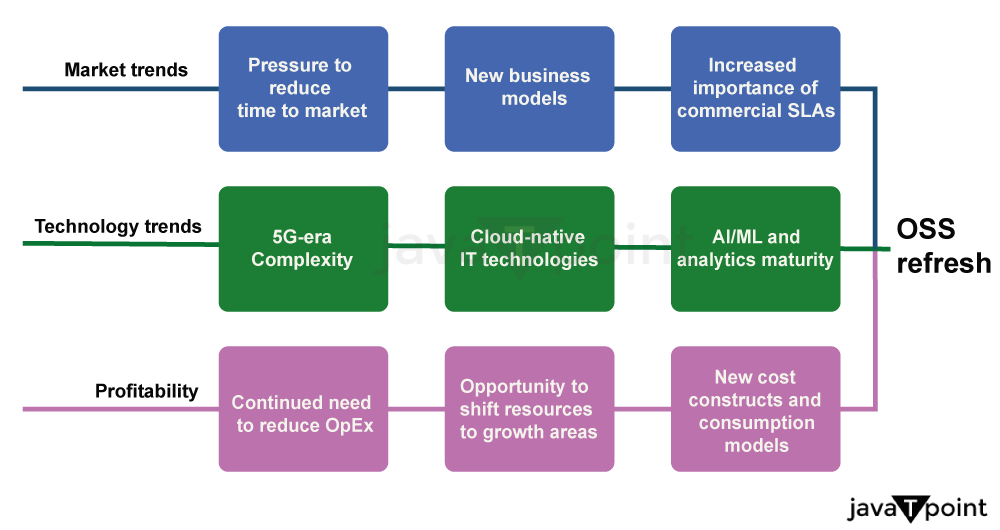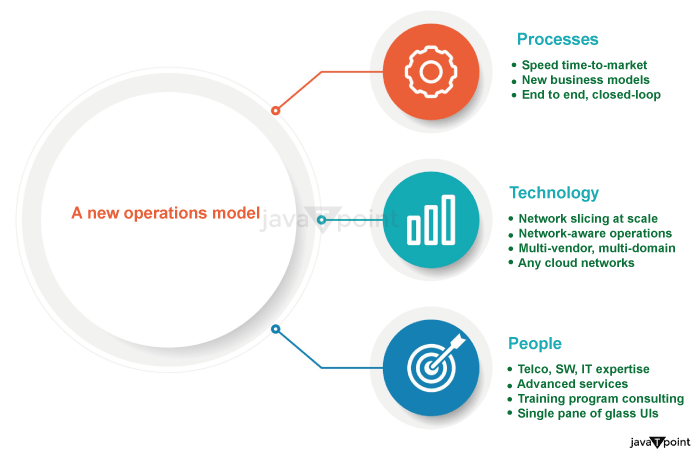Operating System in Nokia
Operations Support Systems (OSS): What are they?
For more than 30 years, traditional operations support systems (OSS) have helped communications service providers (CSPs) manage their networks. Due to the dynamic market pace demands of the 5G age, the growing need to interact with vertical industry companies, and the order of magnitude increase in network complexity, we have now hit a point where it is necessary to update these systems substantially.
As distinctive and significant to the telco sector as comparable systems are to other sectors is the use of Operations Support Systems (OSS) systems. Just think about finance operations systems in the banking business or airport operations systems in the transportation sector. The key argument is that systems created especially for particular sectors produce the best outcomes. These tools need to be updated occasionally.
What drives the need for OSS to change for the 5G era?
Let's concentrate on digital transformation to pinpoint the three major trends that make now the ideal moment to implement these changes in the telecom sector.

Market developments that affect operational support systems (OSS)
The time has come for CSPs to take advantage of the increased network capabilities brought on by the 5G era and advance into niche sectors more than their conventional customer markets. They will require Operations Support Systems (OSS) that enable:
- Faster time to market and revenue for new services than ever before • New kinds of business models - particularly to interact with Enterprise vertical partners - to progress towards AI-enabled operations. Various "as a Service" business model designs will be included.
- Swift adoption and maintenance of business Service Level Agreements (SLAs), which will come to be accepted parlance with Enterprise Partners.
Trends in technology that affect operations support systems (OSS)
The technical features of the 5G era networks and the advanced IT technologies include:
- The 5G era networks are more complicated and functionally wealthy. However, they are software-based, which is a persuasive argument for using cutting-edge systems that can efficiently handle networks at scale.
- Telecom operations systems can now fully benefit from the newest cloud-native IT capabilities because IT technologies have advanced and technical barriers have been removed.
- AI/ML and other advanced analytics technologies have also matured, and the market now expects their use for use-case-based benefits.
Operation Support Systems are affected by cost constraints. (OSS)
The challenge of profitability has never been greater, and modernized systems and technology can:
- Scalable Operating Expense (OpEx) savings through increased automation of current processes and the introduction of previously impractical new automation-native processes.
- These skilled resources can be reassigned to bring new service offerings to market by updating these Operations Support Systems (OSS) to utilize automation and intelligence.
How can the shortcomings of the current operations support systems be fixed?
Service and network operations must change in three areas to successfully transition from these conventional Operations Support Systems (OSS).

Processes for company activities should change.
Here, we're referring to the procedures that must be followed to run their company. Processes for service and network operations that have been used for a long time may be better moving forward as we progress toward automation and AI-assisted operations. The goal of this endeavor is not to automate the current processes; rather, it is to research and design the best processes for the future, which in many instances, may vary from the current modes of operation.
Utilize cutting-edge IT techniques for OSS.
Here, we allude to the underlying IT and physical technologies that make up networks. We are, in fact, at a stage where service and network operations can completely utilize the entire spectrum of IT technologies because networks are now software-based and programmable.
Develop fresh perspectives and competencies for OSS employees
possibly the most significant element. When referring to the personnel in the traditional Network Operations Center (NOC) and Service Operations Center (SOC) divisions, we refer to their knowledge, experience, training, and general point of view. It will take innovative methods to the necessary skill sets and strategy that can be adopted to promote the transformation to utilize the technology and process changes fully.

How can you choose a dependable collaborator to help your Operations Support Systems (OSS) evolve?
Strong relationships across the operations environment will make navigating this transformative period easier. The requirement is frequently for multi-vendor, multi-domain, and multi-technology settings; this is a fact.
The best partners for enhancing service and network operations are those with goods and solutions throughout the ecosystem. These partners have a unique viewpoint and depth of knowledge. Buyers gain from the participation of partners that offer the complete complement of solutions even when they choose particular components of their ecosystem from other suppliers because they have a better grasp of how everything must function together.
According to Nokia, there are a few key routes that service and network operations should take as they develop. These routes frequently mix and cross, but they can also be different at other times. These serve as essential building blocks for the goods, services, and answers we provide:
Solutions for intent-based networks
The time when network intricacy should determine how services are positioned and made available to the market is long gone. Instead, these systems must understand and act upon information in ways that existing Operations Support Systems (OSS) cannot reduce conflict between themselves and their markets.
Benefits of the OSS "as a Service" approach
novel methods to ingest results from their vendors rather than just new ways to access hosted instances of supplier goods. To produce the desired results, the suppliers must decompose their goods in ways that make this possible.
Criteria that are pertinent to operations support systems (OSS)
It will be essential to depend on infrastructure- and application-based standards as networks and management apps become more disaggregated. Although individual vendors will still provide complete, pre-integrated solutions, buyers will need to be able to choose components that all adhere to functionalities and interfaces that are based on standards.
What requirements are you for Operations Support Systems (OSS), and how can Nokia help?
Are you looking for an end-to-end orchestration and verification system that supports multiple vendors? Or are you searching for top-tier network domain-specific administration and control tools? Nokia offers goods, services, and operational support systems (OSS) options tailored to your needs.
- Nokia's multi-vendor framework for managing the design, implementation, and assurance of services across the various network domains is called the Digital Operations Center, which also contains the Orchestration Center and the Assurance Center.
- The network administration solution for enterprises, mobile & packet core, cloud RAN, and traditional RAN is called Nokia NetAct. EdenNet SON offers self-organizing mobile network intelligence
- Nokia's IP and optical network administration solution is called the Network Services Platform.
- Nokia's cloud management tool, Cloud Operations Manager, controls the location and processing infrastructure for virtualized and containerized network tasks. Altiplano is Nokia's fixed network access management platform.
Why do new Operations Support Systems (OSS) use Nokia?
Nokia provides solutions across all practical software levels and all currently available networking areas. With this extensive portfolio, Nokia is in a unique situation to offer reliable alliances as customers determine their future course.
The fact that Nokia builds and delivers components at every level and layer gives us an intimate understanding of what is required to stitch together to optimize everything, whether or not they purchase their entire solution footprint from Nokia - and many cannot due to their procurement policies. As a result, Nokia can contribute positively to these initiatives because we are familiar with the requirements for success.
Nokia is dedicated to providing our extensive inventory while strictly upholding relevant industry standards. We frequently find ourselves accelerating the speed of these standards organizations to reduce the time between the demands of early adopters and the complete ratification of the standards to support our clients.